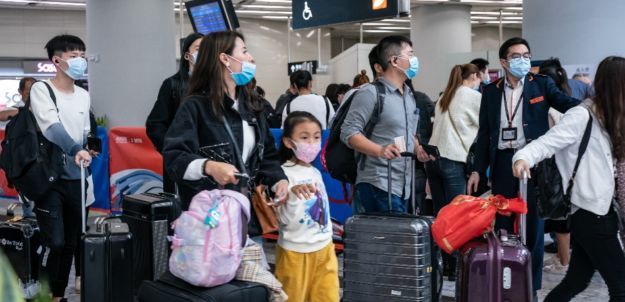Coronavirus in Spain is ‘frightening on every level’. So how did things get so bad there?

“It’s frightening on every level.”
That’s the stark way Australian expat Mandy Keillor describes life in coronavirus-hit Spain.
“We say to our community not to keep looking at the figures and what’s going on,” she said.
“But you can’t help it, because you have to be aware of what’s happening.”
Ms Keillor and her partner Natalia Laing have called Barcelona home for 14 years, and run a wellness centre there.
“From the point of view of support, for us it’s not very good,” Ms Keillor told the ABC.
“We’re a country that’s still in recession, so we haven’t got the money that other countries have to be able to bail people out or support them.
“So from the business point of view, the small business point of view, it’s devastating.”
Spain in lockdown as coronavirus deaths near Italian levels
Spain is on a horrifying upward trajectory, having now surpassed China in the number of cases and fast approaching Italy when it comes to the number of deaths.
On Tuesday (local time), a record 849 people died, bringing the total death toll to 8,189, while some 85,000 people have tested positive for COVID-19.
In response, the country’s capital, Madrid, held a minute’s silence for those lost.
Under tough new lockdown rules in the country, all non-essential workers are banned from travelling to work.
People are only allowed outside to get food, visit a chemist or walk a pet. Everyone must also carry documentation explaining the outing.
“It’s slowly becoming more uncomfortable,” Ms Laing said of the lockdown, which is now in its third week.
“I’m taking my dogs for small walks and I have to [explain it] every time I go out there.
“There is this feeling … a very strange feeling.”
So far, she and her partner have spent their days in isolation busily trying to reinvent their business into an online service.
“We don’t have a crystal ball and we can’t see what’s coming, and that’s probably the most frightening thing to be honest,” Ms Keillor said.
“Because you don’t know what to prepare for and how long this is going to go for.”
How ‘Game Zero’ might have spread COVID-19 to Spain
 There would have been hardly any social distancing or preventative cleaning measures at the San Siro stadium.
There would have been hardly any social distancing or preventative cleaning measures at the San Siro stadium.It’s remarkable how quickly the coronavirus has spread around Spain, but an explanation on one of the ways it might have got there dates back to a soccer game in Milan.
Last week, the Associated Press reported how almost a third of citizens from one of the worst-hit regions in Italy, Bergamo, made a short trip to Milan’s famed San Siro Stadium on February 19 to watch their team, Atalanta, in a Champions League match against Spanish side Valencia.
Nearly 2,500 Valencia fans also attended the match, which had an official attendance of 45,792 and has been dubbed by some media as “Game Zero”.
Bergamo Mayor Giorgio Gori acknowledged the conditions for virus contagion would have been high at the match during a live Facebook chat in Rome last week.
“If it’s true what they’re saying that the virus was already circulating in Europe in January, then it’s very probable that 40,000 Bergamaschi in the stands of San Siro, all together, exchanged the virus between them,” he said.
“As is possible that so many Bergamaschi that night got together in houses, bars to watch the match and did the same.”
There would have been hardly any social-distancing or preventative cleaning measures in place at the time. Nearly 30 busloads of fans made the 60-kilometre trip from Bergamo to Milan, according to AP.
Leaving the San Siro, Valencia fans might have brought back coronavirus to Spain.
Less than a week after the game, the first COVID-19 cases were reported in the province of Bergamo.
At the same time in Valencia, a journalist who travelled to the match became the second person infected in the region.
It didn’t take long before people who were in contact with him also had the virus, as did Valencia fans who were at the game.
The head of Italy’s Superior Institute of Health Silvio Brusaferro has indicated that the match is “one of the hypotheses” being evaluated as a source of the crisis in Bergamo.
As one respiratory specialist told AP, the match was a “biological bomb” which might explain why 35 per cent of Valencia’s team became infected.
Another immunologist told the Washington Post that he would imagine “many didn’t want to miss that game if they had tickets, even if they felt a slight fever”.
It’s difficult to confirm how many cases resulted from the match, but the head of the intensive care unit at the Pope John XXIII hospital in Bergamo, Luca Lorini, says it will be investigated.
“I’m sure that 40,000 people hugging and kissing each other while standing a centimetre apart — four times, because Atalanta scored four goals (the final result was 4-1) — was definitely a huge accelerator for contagion,” she told The Associated Press.
“Right now we’re at war. When peacetime comes, I can assure you we will go and see how many of the 40,000 people who went to the game became infected.”
What the experts are saying about coronavirus:
Spain’s health system already feeling the strain
Back in Spain, health officials say the nation is at a peak and the spread is slowing, with new infections rising at around 12 per cent a day, compared to 20 per cent before March 25.
That’s despite the nation’s health emergency chief, Fernando Simon, being among those who have tested positive to COVID-19
While the increase in the number of infections is slowing, a lot of pressure has already been placed on health and funeral services.
More than 12,000 Spanish health workers are among those who have recorded positive tests, equating to 14 per cent of the confirmed cases.
Funeral providers are also struggling to cope with the increased demand.
One provider, Grupo Memora, says it’s performing six times the usual number of funerals in Madrid.
“Madrid has been for probably seven days very, very intensive and it’s still increasing,” Grupo Memora spokesman Fernando Sanchez Tulla told the ABC.
“We are multiplying by six the number of normal services we perform in that area.
“So in the end it’s been a very stressful situation for our teams.”
 Spain has now surpassed China in the number of cases and is fast approaching Italy when it comes to the number of deaths.
Spain has now surpassed China in the number of cases and is fast approaching Italy when it comes to the number of deaths.Mr Sanchez says funeral services are the last part of the health system, and they cannot afford to fail.
“We are not a public service in Spain, but we are acting as a public service,” he said.
“This is, as we say in Spain, an essential service for the community.
“The society needs our services to be performed as soon as possible and we are very closely linked with the national health system — talking to them every day, meeting through Skype or other systems — because we are a very important part of their capacity to [free up] resources in the hospitals.
“If death occurs in a hospital, the quicker we get that corpse out of the hospital, the sooner someone will be able to have the possibility to get a new bed.”






